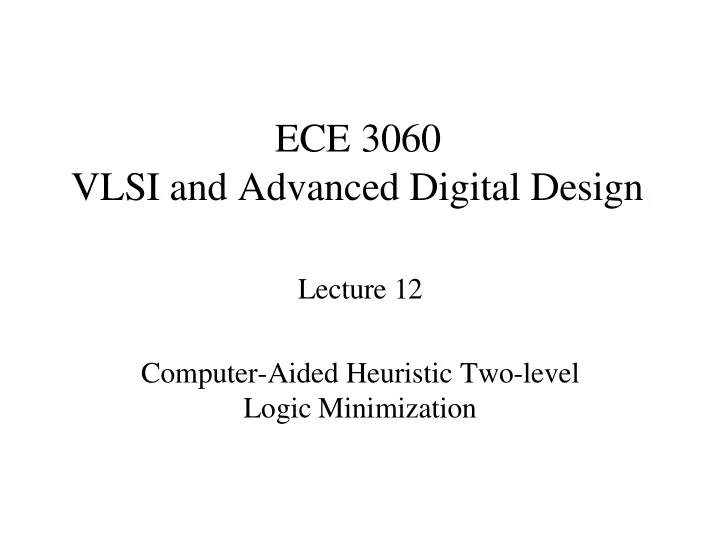

ECE 3060 VLSI and Advanced Digital Design Lecture 12 Computer-Aided Heuristic Two-level Logic Minimization
Computer-Aided Heuristic Two- level Logic Minimization • Heuristic logic minimization • Principles • Operators on logic covers • Espresso Disclaimer: lecture notes based on originals by Giovanni De Micheli
Heuristic minimization • Provide irredundant covers with ‘reasonably small’ cardinality • Fast and applicable to many functions • Avoid bottlenecks of exact minimization – Prime generation and storage – Covering
Heuristic minimization principles • Local minimum cover: – given initial cover – make it prime – make it irredundant • Iterative improvement: – improve on cardinality by ‘modifying’ the implicants
Heuristic minimization operators • Expand: – make implicants prime – remove covered implicants • Reduce: – reduce size of each implicant while preserving cover • Reshape – modify implicant pairs: enlarge one implicant enabling the reduction of another • Irredundant: – make cover irredundant
Example on-set : 0000 1 prime implicants : α | 0**0 1 β | *0*0 0010 1 1 γ | 01** 0100 1 1 δ | 10** 0110 1 1 ε | 1 *01 1000 1 1 ζ | *101 1010 1 1 0101 1 0111 1 1001 1 1011 1 1101 1
α β γ ε ζ
Example Expansion • Expand 0000 to α = 0**0 – drop 0100, 0010, 0110 from the cover • Expand 1000 to β = *0*0 – drop 1010 from the cover • Expand 0101 to γ = 01** – drop 0111 from the cover • Expand 1001 to δ = 10** – drop 1011 from the cover • Expand 1101 to ε = 1*01 • Cover is { α , β , γ , δ , ε }
Example reduction • Reduce 0**0 to nothing • Reduce β = *0*0 to β = 00*0 • Reduce ε = 1*01 to ε = 1101 • Cover is { β , γ , δ , ε }
Example reshape • Reshape { β , δ } to { β , δ } • where δ = 10*1 • Cover is { β , γ , δ , ε }
Example second expansion • Expand δ = 10*1 to δ = 10** • Expand ε = 1101 to ζ = *101
Summary of Example • Expansion: – Cover: { α , β , γ , δ , ε } – prime, redundant, minimal w.r.to single cube containment • Reduction: – α eliminated – β = *0*0 reduced to β = 00*0 – ε = 1*01 reduced to ε = 1101 – Cover: { β , γ , δ , ε } • Reshape: – { β , δ } reshaped to { β , δ } where δ = 10*1 • Second expansion: – Cover: { β , γ , δ , ζ } – prime, irredundant (= minimal)
Expand naive implementation • For each implicant – for each non-* literal ( care literal) 8 raise it to * ( don’t care ) if possible – remove all covered implicants • Problems: – check validity of expansion: 2 ways 8 non intersection of expanded implicant with OFF-set • requires complementation of ON-set 8 expanded implicant covered by union of ON-set and DC-set • can be reduced to recursive tautology check – order of expansions
Heuristics • First expand cubes which are unlikely to be covered by other cubes – Selection: choose implicants with least number of literals in common with other implicants – Example: f = a’b’c’d’ + ab’cd + a’b’c’d choose ab’cd • Choose expansions to cover the largest number of minterms possible (=> prime implicant)
Reduce Example • Expanded cover: 8 α **1 8 β 00* • Select α : cannot be reduced and still cover the ON-set • Select β : reduced to 8 β 001 • Reduced cover: 8 α **1 8 β 001
Irredundant Cover • Relatively essential set E r – implicants covering some minterms of the function not covered by other implicants • Totally redundant set R t – implicants covered by the relatively essentials • Partially redundant set R p – remaining implicants
Irredundant cover goal and example • Goal: find a subset of R p that, together with E r , covers the function • Example: 8 α 00* 8 β *01 8 γ 1*1 8 δ 11* 8 ε *10 • E r = { α , ε} • R t = {} • R p = { β , γ , δ }
Example: continued • Covering relations: – β is covered by { α , γ } – γ is covered by { β , δ } – δ is covered by { γ , ε} • Minimum cover: γ U E r
Espresso Algorithm • Compute the complement • Extract essentials • Iterate: – expand, irredundant, reduce • Cost functions: – cover cardinality Ø 1 – weighed sum of cube and literal count Ø 2
Espresso algorithm Espresso( F,D ) { R = complement( F U D ); F = expand( F, R ); F = irredundant( F, D ); E = essentials( F, D ); F = F - E ; D = D U E ; repeat { Ø 2 = cost( F ); repeat { Ø 1 = | F |; F = reduce( F, D ); F = expand( F, R ); F = irredundant( F, D ); } until (| F | z Ø 1 ); F = last_gasp( F, D, R ); } until cost( F ) z Ø 2 ; F = F U E ; D = D - E ; F = make_sparse( F, D, R ); }
Summary heuristic minimization • Heuristic minimization is iterative • Few operators applied to covers • Underlying mechanism – cube operation – recursive paradigm • Efficient algorithms • Preview: next lecture covers efficient boolean representations for computer manipulation
Recommend
More recommend